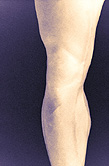
THURSDAY, April 28 (HealthDay News) — Men who are both obese and tall face a much higher risk for developing potentially fatal blood clots, though overall the risk remains quite small, according to a new study.
The researchers report that extra weight and extra inches together seem to raise the risk more than either alone.
“Tall and obese men had more than a fivefold higher risk, compared to short and lean men,” said the study’s co-author, Sigrid K. Braekkan, who warns the vertically and horizontally gifted to avoid sitting in one place for too long.
Women also face a higher risk if they’re both obese and tall, but just being tall alone doesn’t seem to be a problem, the study found.
The clots lead to a condition known as deep vein thrombosis, which may be best known as an affliction that strikes passengers on long plane flights who don’t have much chance to move around. Immobilization of the legs can contribute to the condition.
Other causes include injury and a genetic condition that makes people’s blood more likely to clot. “And there are some people who seem to get clots when they don’t have any clear, obvious risk factors,” said Dr. Victor Tapson, director of the Center for Pulmonary Vascular Disease at Duke University.
Though the clots start in the leg, they can move to the lung, where they may cause a deadly pulmonary embolism. Venous thromboembolism is the term used to describe the two conditions — deep vein thrombosis and pulmonary embolism — together.
In the new study, published online April 28 in Arteriosclerosis, Thrombosis and Vascular Biology, researchers collected data on 26,714 people from 1994 to 2007, including 461 reports of venous thromboembolism.
Obese and tall men — those at least six feet tall — had more than five times the risk for a clot, compared with normal-weight men shorter than 5 feet 7 inches. The risk was three times higher for women who were obese and at least 5 feet 6 inches than for normal-weight women shorter than 5 feet 3 inches.
The higher risk for tall people appears to be related to their circulatory system. “The distance for blood to return to the heart and lungs is longer,” Braekkan said. “Since the blood must be pumped upwards against the force of gravity by the calf-muscle pump, the longer distance may cause reduced flow in the legs and, thereby, higher risk of clotting.”
He said that obesity causes pressure in the abdomen that may hinder the ability of the calf-muscle pump to send blood back up into the body.
The study found, however, that the risk for developing blood clots remained low, even for the tall and obese.
But what should obese and tall people do to lower their risk even more? Until pounds can be shed, the best thing to do is to avoid situations where you’re not moving for long periods of time, Tapson said.
Even in the cramped space of a plane, try “just moving your legs, shifting your legs, going up and down on your toes and flexing your feet back and forth to keep your calf muscles stimulated,” he said. It’s also a good idea to keep hydrated (and alcohol doesn’t help on that front). Some people use elastic socks, although Tapson said they may be troublesome if they crimp the legs.
More information
The U.S. National Heart, Lung and Blood Institute has more on deep vein thrombosis.

